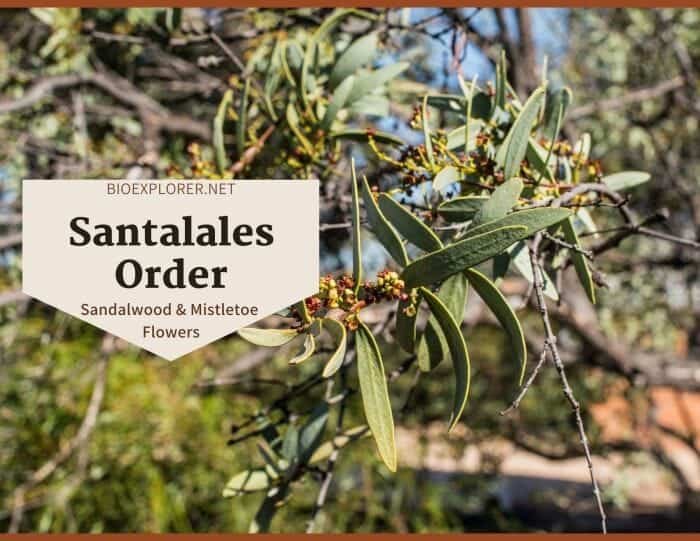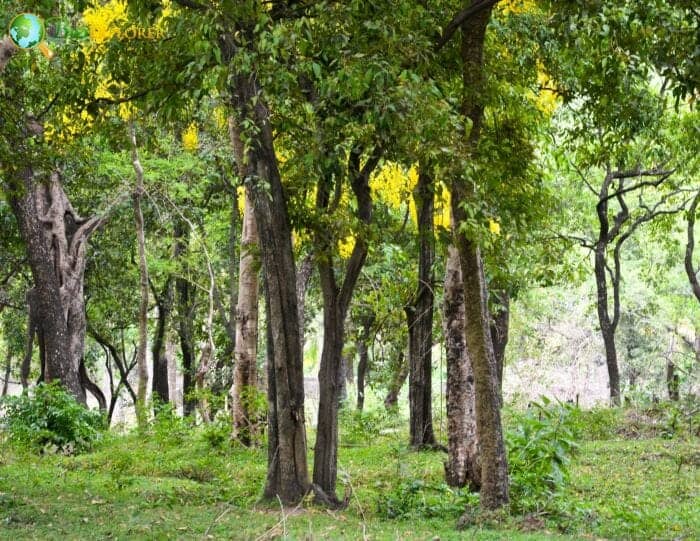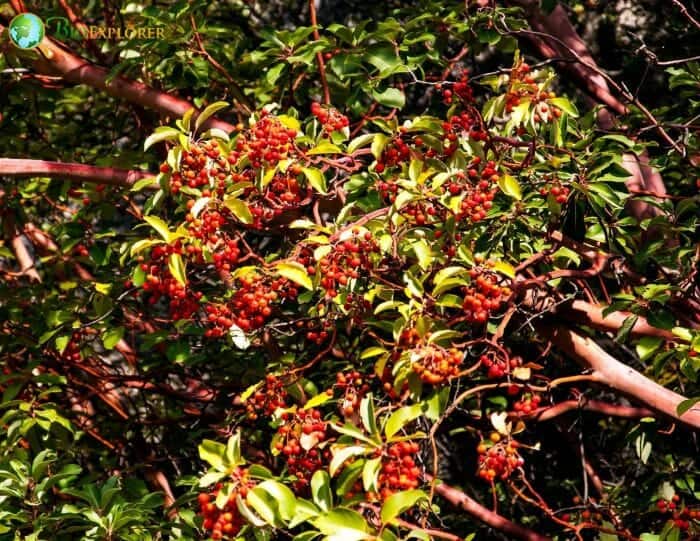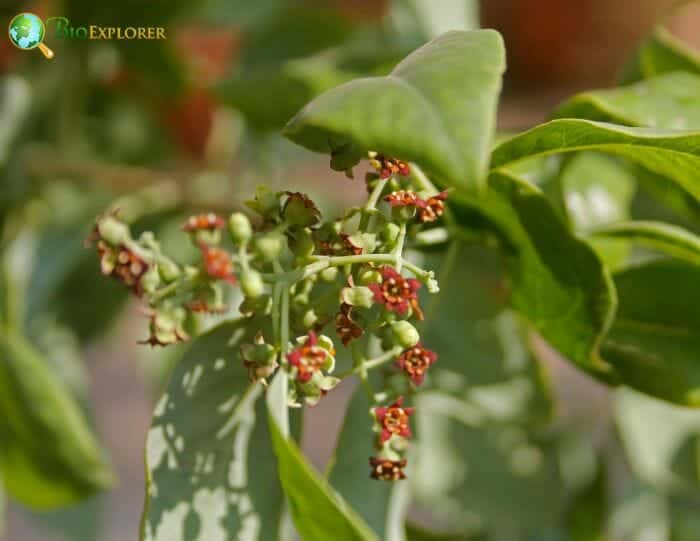
Santalales is one of the most prominent groups of parasitic flowering plants, with species distributed worldwide. Santalales involve plants that form haustoriumWhat is haustorium?A specialized root of parasitic vascular plants capable of penetrating and absorbing food and other materials from host tissues. to penetrate the host’s barks and roots, plants that undergo photosynthesizing activities in the stem, and members with usually simple and exstipulateWhat is exstipulate?Without stipules; Stipule is a small structure of appendage found at the base of some leaf petioles. leaves.
The Santalales flowers are bisexual or unisexual and are generally pollinated by nectar-foraging birds, moths, bees, wasps, and flies. Sandalwood and mistletoes are just two of the known plants under Santalales.
Table of Contents
Santalales Families
Many studies present different quantities of families under Santalales. But due to the differences in sampling results, the relationship between the families and even which families should be placed in this order is still not fully determined[1]. For example, the APG IV system (2016) accepted seven families belonging to Santalales. This value is also used in the World Flora Online[2].
- Balanophoraceae (Snake-mushroom family)
- Loranthaceae (Showy mistletoe family).
- Misodendraceae (Feathery-mistletoe family)
- Olacaceae (Tallow-wood family)
- Opiliaceae (Bally-coma family
- Santalaceae(Sandalwood family)
- Schoepfiaceae (Arana family)
![]()
Santalales Distribution

The species of Santalales are distributed worldwide. However, its heavy concentration is found in tropical and subtropical regions.
- The species Santalaceae[3] (40 genera and 990 species[4] )are found worldwide. Species are found in the dry or temperate regions or the humid tropical biomes.
- Loranthaceae (89 genera and 886 species) are scattered worldwide. The Loranths are incredibly diverse in Africa and Australia’s seasonally dry habitats. A few species of this family also exist in temperate Europe, Asia, Australia, New Zealand, and South America.
- The Olacaceae[5] (27 genera and 149 species) has a pantropical distribution. However, members are also found in subtropical North and South America. The plants under this family can survive under low nutrients and water by attaching to their hosts during dry periods.
- The Opiliaceae[6] (10 genera and 33 species) members are also pantropical, extending their distribution to temperate Australasia. They are mainly distributed in the Old World. Only one genus, Agonondra, is found in the Neotropics.
- Balanophoraceae (16 genera and 45 species) have a tropical to subtropical distribution. They are also found in South Africa, the Himalayas, China, Japan, and New Zealand.
- The members of Misodendraceaea (1 genus and 8 species) are widespread. This family is more diverse in the Southern hemisphere, chiefly in Australia. However, diversity in flower morphology is also found in South America.
![]()
Santalales Characteristics

Below are some of the characteristics shared by the members of Santalales:
- Plant type: Santalales members are trees, lianas, shrubs, herbs, and terrestrial and evergreen vines. They are characterized as parasitic. Most of them are hemiparasitesWhat is hemiparasites?A parasitic plant containing chlorophyll and therefore partly self-sustaining as in mistletoe.. They can undergo photosynthesis and produce sugars, but they get water and minerals by attaching them to the roots or stems of other plants. Somespecies are holoparasitesWhat is holoparasites?A plant lacking chlorophyll and entirely dependent on its host for nourishment. They are subdivided into stem or root parasites depending on which part of the host they attack. and depend on a significant part of their nourishment from their hosts.
- Roots: In Santalaceae, the roots are present or absent. The mistletoe after germination, uses the modified root, haustorium, to penetrate the bark or the root of the host.
- Stem: Surface hairs are found on the stems of some species. Some species transfer the photosynthesizing function to the stem.
- Leaves: Almost all species have simple leaves; exstipulate. There are surface hairs on a few species’ leaves.
- Flowers and Inflorescences: Variation in the inflorescence and flower morphology in this order is extreme. (Please see the flowers and reproduction and family differences section of this page).
- Sepals and Petals: Some flowers have both sepals and petals. Others have either or none at all.
- Stamens and Carpels: The stamens are found opposite the petal’s lobes and are typically equal to the quantity of the petals. The carpels are usually 2-5.
- Ovary and Fruits: The ovaries are superior, partly inferior, or inferior (mostly). The species have remarkable ovule, embryo sac, and embryo development. The Loranthaceae do not have integuments in the ovules. Other families have pendulous ovules in the free central placenta. The fruit is a berry, drupe, nut, or achene.
- Seeds: The seeds of the members mostly lack testae (seed coats).
![]()
Santalales Flowers and Reproduction

The Santalaceae flower size varies considerably. Most species are small and inconspicuous. Although some members (Santalum and Quinchamalium) have showy flowers of moderate size.
- They can occur singly or in groups found on short spikes or in the axils of the leaf. The flowers are monochlamydous, unisexual or bisexual, actinomorphicWhat is actinomorphic?A characteristic of the flower exhibiting radial symmetry such as starfish or Daisy flower; capable of being bisected into identical halves along more than one axis, forming mirror images. Opposite is Zygomorphic., and bracteateWhat is bracteate?Possessing or bearing bracts.. The species Santalum album[7] undergoes strict cross-pollination by insects, usually the bees and the flies.
- The showy mistletoe or Loranthaceae flowers[8] are usually hermaphrodites. Some species are unisexual. They are often yellow, orange, or red. The inflorescences are in aggregations of cymose units, usually in triads (the flowers often in threes).
- Most of the flowers possess two perianth whorls (dichlamydous). The calyxWhat is calyx?A collective term for all the sepals of a flower; the lowermost whorl of floral orgrans (Plural form is calyces). and corollaWhat is corolla?A collective term referring to the petals of a flower. are distinct, or the calyx is calyculusWhat is calyculus?A simulated calyx composed of bracts or bracelets. (much reduced). Sometimes the calyx is absent. The 4-9 petals of the flowers can be free (cloripetalous) or fused (gamopetalousWhat is gamopetalous?Having petals which are partly or completely fused (connate).).
- They have an inferior ovary with no ovules. Pollination in this family is entomophilyWhat is entomophily?Pollination by insects. Contrast anemophilous (wind-pollination). and ornithophilyWhat is ornithophily?Pollination by birds; other types are anemophily (wind-pollinated) and entomophily (insect-pollinated)..
- The small (2-10 mm), chloripetalous, and white or greenish flowers are usually pollinated by insects, while the large (30-160 mm), brightly colored, and gamopetalous flowers are typically pollinated by birds.
- The Olacaceae flowers are actinomorphic and bisexual or partially unisexual. The inflorescences of the flowers can be in cymes, racemes, fascicles (axillary), umbel, or spikes. Usually, the sepals 5, rarely 3 to 7, are fused and form a cup shape calyx. Some species lack sepals. Their petals, usually 4 or 5, rarely 3 to 7, are slightly fused or free.
- A Member of this family may or may not have a nectary disc. If present, it is found between the stamens and the style. The stamen is usually 4 or 5 (or 8-10) in 1 or 2 whorls.
Generally, the Santalales species[9] are pollinated by nectar-foraging birds, moths, bees, wasps, and flies. The birds, wind, and explosion are the means to disperse the fruit or seed.
![]()
Santalales Family differences
The Sandalwood[10] is an order of parasitic flowering plants with exceptionally diverse growth habits. There are holoparasites and depend mostly on their hosts. However, most species have at least some chlorophylls and can still undergo photosynthesis.
The following are the differences of the principal families (families with the most number of genera):
Loranthaceae
- Members of this family are trees, lianas, or shrubs. They are mostly “normal” plants. Others species are “switch plants“, having the principal photosynthesizing function transferred to stems.
- They usually have well-developed leaves. The leaves of a few species are much reduced. The plants are rootless or with roots. The members of this family are partially parasitic and mainly attached to the host’s aerial parts or sometimes to the roots. Loranthaceae are mesophyticWhat is mesophytic?Plants that grow in environments that are neither very wet nor very dry; plants intermediate in moisture requirements between hydrophytes and xerophytes. or xerophyticWhat is xerophytic?A plant that is adapted to dry or arid habitats (definition for xerophyte)..
- The leaves are simple, usually opposite, leathery, and exstipulate. The leaf blade and margins are both entire. They can be one-veined, pinnately veined, or parallel-veined. Persistent basal meristemWhat is meristem?Specialized groups of cells that are a plant's growing points. is absent in the leaves.
- The plants are primarily hermaphroditeWhat is hermaphrodite?An organism or structure possessing both male and femal reproductive organs; a flower with both stamens and pistils. Other synonyms: bisexual or monoclinous..
- The flowers can be small or large. The inflorescences are in aggregations of cymose units, usually in triads (the flowers often in threes).
- The flowers are dichlamydous. The calyx and corolla are distinct, or calyx is much reduced or absent in some species. The petals are 4-9; free or fused.
- The stamens are isomerous with the perianth; opposite the petals (alternisepalous).
- The gynoecium has 3-4 carpels. The ovary is inferior and unilocular. The ovules are not differentiated.
- The fruit is usually a berry. Other species have a drupe or a nut. The seed is copiously endospermic and oily; without a testa.
![]()
Santalaceae
- Members of this family are trees, shrubs, and herbs. They are typical plants or switch plants. The leaves are well developed or much reduced. The roots are present or absent. The species are green and able to undergo photosynthesis. They are hemiparasites on the roots or the aerial parts of their hosts. Santalaceae are mesophytic or xerophytic.
- The leaves of the members are mostly opposite. Some are alternate. They are simple. The lamina is entire, and the leaves are exstipulate.
- They are often unisexual. The plants under Santalales are hermaphrodite, or monoeciousWhat is monoecious?Pertaining to plants, individuals of which bear both staminate and pistillate flowers, but not necessarily perfect flowers., or dioeciousWhat is dioecious?Pertaining to plants, individuals of which bear either staminate or pistillate flowers, but not both..
- The flowers are small and bracteate. They can be solitary or aggregated in racemes, spikes, fascicles, heads, or cymes.
- The perianth is uniseriate and valvateWhat is valvate?Sepals having adjacent edges abutting rather than overlapping; opening by valves; edges of structures coming together so that the margins touch but won't overlap.. They can be sepaloid or petaloid.
- The stamens are 3-8; antitepalous; isomerous with the perianth.
- The carpels are 2-5. The ovary is partly inferior to inferior. Their placentation is basal or free central.
- The fruit is a drupe, a berry, or a nut. The fruit is 1-seeded. The seeds lack testa (a seed coat).
![]()
Balanophoraceae
- The members are fleshy, herbaceous parasites that grow on the roots or rhizomes of their hosts. The leaves are scale-like, alternate, and spirally arranged.
- The plants under this family lack chlorophyll and stomata. The species form an underground tuber where the rhizomes grow, forming haustoria that attach to the host’s roots.
- The flowers are tiny, unisexual, and actinomorphic. The inflorescences are in terminal racemes that are reduced to spadices. These inflorescences consist of unisexual flowers or both male and female flowers.
- The female flowers are smaller than the male flowers. In male flowers, the petals are lacking. The free or fused sepals can be 3 or 4, rarely 8. Some species also lack sepals.
- The female flowers are crowded. As a result, both the sepals and petals are absent. If present, they are reduced to 2 free or fused tepals.
- The stamens are as many as the sepals. If the sepals are absent, the stamens are 1-2.
- The ovary is inferior with 2-3 fused carpels.
- The fruit is an achene.
![]()
Olacaceae
- Members of this family are terrestrial and evergreen vines, shrubs, and trees. Mostly, they are green and autotrophic. However, some members are parasitic that attach to their hosts through their haustorical connections.
- The leaves are simple, alternate, distichousWhat is distichous?Two-ranked, with leaves or flowers in two opposite rows in the same plane., or arranged spirally. The petioles are well developed. The stipules are lacking. Their leaf blade possesses pinnate venation, and the leaf margins are entire or toothed.
- The flowers are actinomorphic and bisexual or partially unisexual. They are in inflorescences of cymes, racemes, fascicles, spikes, or umbels (simple or compound).
- There are usually 5 fused sepals forming a cup shape. However, this calyx is sometimes absent in some species. The petals are also five, free or slightly fused.
- The stamens are commonly 4-5, sometimes 8-10; in 1 or 2 whorls.
- The ovary is superior or half inferior. The carpels are 3-5; fused.
- The fruits are drupes.
![]()
Santalales Example species
The species under this order are mostly parasitic. However, these plants still provide beneficial uses. The following are some of the example species of Santalales:
- Aromatic Sandalwood – The species is economically important in perfumery and furniture making.
- Fungus root – The plant has medicinal use.
- Moodjar or Western Australian Christmas tree[11] – The plant has potential for medicine.
- Large sourplum – The plant is beneficial. It can be a source of food (fruit), oil (from seeds), firewood (from wood), and medicine[12].
- Tallowwood[13] – This tree is very beneficial. It is a source of food (fruit), oil (from fruit), essential oils (from heartwood and flowers), and firewood or charcoal (from wood). The tree is also grown as ornamental. It is extensively utilized as a medicinal plant. The leaves are also vital as a source of animal feed.
- Ivory wood tree[14] – The fruits of this plant can be cooked, and the roots are used to make a frothy drink. The wood is of good quality for export. Aside from being an ornamental plant, it is also a source of fuel and charcoal. Additionally, the parts (leaves, bark, and roots) are of great medicinal value.
- Reed’s False Olive[15] – The plant is used for traditional medicine. The plant is potentially useful[16] for its anthelminthic activity.
- Northern Sandalwood – The plant is used as traditional medicine.
- Bitter quandong – The bark of the roots is edible after roasting.
- Wood rose[17] – This plant is sometimes used as ornamental. It also has medicinal value.
![]()











